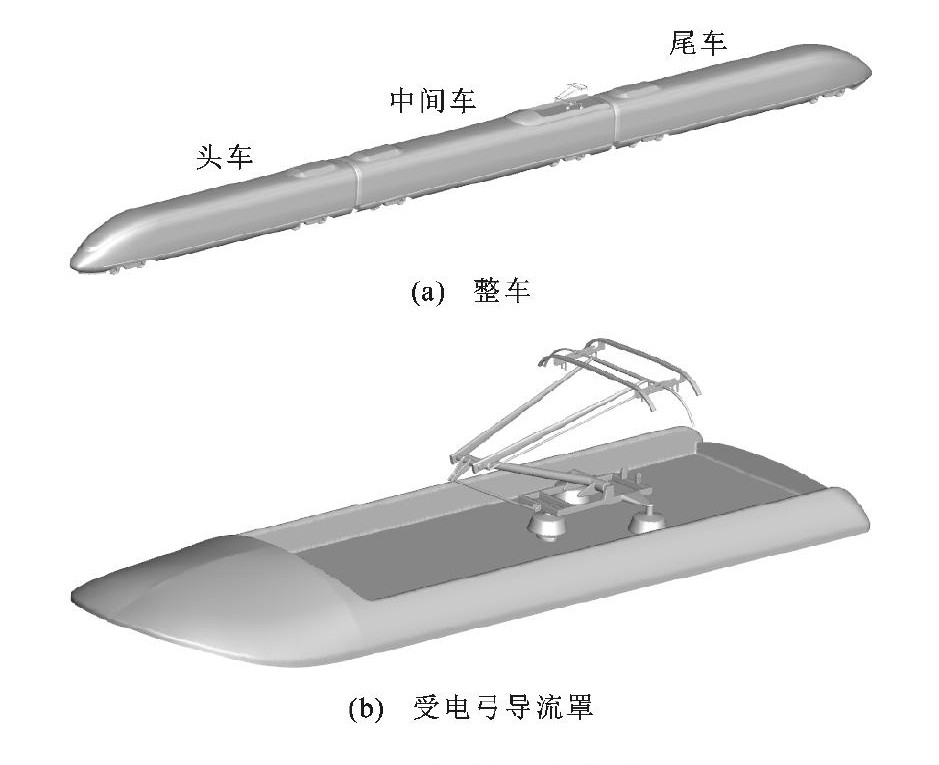Contribution analysis of aerodynamic noise of high-speed train
-
摘要: 建立了3节编组的CRH380B高速列车气动噪声计算模型, 包括6个转向架、2个风挡、3个空调机组和1个DSA380型受电弓等细微结构, 采用基于Lighthill声学理论的宽频带噪声源模型对高速列车气动噪声源进行识别, 基于高阶有限差分法的大涡模拟对高速列车近场非定常流动进行分析, 并采用Ffowcs Williams-Hawkings声学比拟理论对高速列车气动噪声进行预测。计算结果表明: 远场噪声计算结果与风洞试验结果的最大差值为1.45dBA, 因此, 高速列车气动噪声计算模型是准确的; 对气动噪声贡献量由大到小依次为转向架系统(6个转向架)、车端连接处(2个风挡)、受电弓与空调机组, 数值分别为83.58、79.31、74.08、59.71dBA; 以受电弓开口方式运行的整车气动噪声贡献量小于闭口方式, 最大声压级和平均声压级分别小于0.40、0.31dBA; 头车一位端转向架对转向架系统气动噪声贡献量最大, 为79.73dBA; 对受电弓气动噪声贡献量由大到小依次为: 碳滑板、平衡臂、弓头支架、底架、绝缘子、下臂杆、铰接结构、上臂杆、拉杆与平衡杆, 数值分别为97.95、93.02、86.63、82.07、79.46、76.85、72.43、66.63、62.02、54.22dBA; 在速度为350km·h-1时, 受电弓气动噪声存在主频为305、608、913 Hz, 且此3阶单频噪声频率是由弓头部位涡流脱落所导致的气动噪声贡献。Abstract: The calculation model of aerodynamic noise of CRH380 Bhigh-speed train with 3 vehicles was established, including some detailed geometries such as six bogies, two windshields, three air conditioning units and one DSA380 pantograph. The aerodynamic noise sources of high-speed train were identified by the broadband noise source model based on the Lighthill acoustic theory. The near-field unsteady flow around the high-speed train was analyzed by using the large-eddy simulation based on the high-order finite difference method. The aerodynamic noise of high-speed train was predicted by using the Ffowcs Williams-Hawkings acoustic analogy theory. Computation result shows that the maximum deviation of calculated result of far-field aerodynamic noise and wind tunnel test result is 1.45 dBA, so the calculation model is accurate. The order based on the aerodynamic noise contribution amounts from large to small is bogie system (six bogies), inter-coach spacing (two windshields), pantograph and air conditioning unit, and the numerical values are 83.58, 79.31, 74.08 and 59.71 dBA, respectively. The aerodynamic noisecontribution amount of train in the knuckle-downstream direction of pantograph is less than the value in the knuckle-upstream direction of pantograph, and the maximum sound pressure level (SPL) and the average SPL are 0.40 dBA and 0.31 dBA, respectively. The aerodynamic noise contribution of the first bogie of head car is biggest and is 79.73 dBA. From large to small in turn, the order based on the aerodynamic noise contribution amounts of pantograph is carbon skateboard, balance arm, panhead support, chassis, insulators, lower arm rod, knuckle, upper arm rod, pull rod and balance rod, and the numerical values are 97.95, 93.02, 86.63, 82.07, 79.46, 76.85, 72.43, 66.63, 62.02 and 54.22 dBA, respectively. At 350 km·h-1, the dominant frequency of aerodynamic noise of pantograph exists 305, 608 and 913 Hz that are resulted from the aerodynamic noise contribution because of panhead's vortex shedding.
-
Key words:
- high-speed train /
- pantograph /
- bogie /
- aerodynamic noise /
- large eddy simulation /
- noise contribution
-
表 1 FLUENT模拟所采用的主要模型特性
Table 1. Main modeling features adopted in FLUENT

表 2 数值仿真与风洞试验声压级对比
Table 2. SPL comparison between wind tunnel test and numerical simulation

表 3 平均声压级对比
Table 3. Comparison of average SPLs

表 4 受电弓以开口方式运行的各部件平均声压级
Table 4. Average SPL of each part in open direction of pantograph

表 5 转向架系统各部件的平均声压级
Table 5. Average SPL of each part of bogie system

表 6 受电弓各部件的平均声压级对比
Table 6. Average SPL contrast of parts of pantograph

-
[1] MELLET C, LTOURNEAUX F, POISSON F, et al. High speed train noise emission: latest investigation of the aerodynamic/rolling noise contribution[J]. Journal of Sound and Vibration, 2006, 293 (3-5): 535-546. doi: 10.1016/j.jsv.2005.08.069 [2] 沈志云. 高速列车的动态环境及其技术的根本特点[J]. 铁道学报, 2006, 28 (4): 1-5. doi: 10.3321/j.issn:1001-8360.2006.04.001SHEN Zhi-yun. Dynamic environment of high-speed train and its distinguished technology[J]. Journal of the China Railway Society, 2006, 28 (4): 1-5. (in Chinese). doi: 10.3321/j.issn:1001-8360.2006.04.001 [3] 张卫华. 高速列车顶层设计指标研究[J]. 铁道学报, 2012, 34 (9): 15-19. doi: 10.3969/j.issn.1001-8360.2012.09.003ZHANG Wei-hua. Study on top-level design specifications of high-speed train[J]. Journal of the China Railway Society, 2012, 34 (9): 15-19. (in Chinese). doi: 10.3969/j.issn.1001-8360.2012.09.003 [4] THOMPSON D J, IGLESIAS E L, LIU Xiao-wan, et al. Recent developments in the prediction and control of aerodynamic noise from high-speed trains[J]. International Journal of Rail Transportation, 2015, 3 (3): 119-150. doi: 10.1080/23248378.2015.1052996 [5] 张亚东, 张继业, 李田. 高速列车气动噪声声源特性分析及降噪研究[J]. 铁道学报, 2016, 38 (7): 40-49. doi: 10.3969/j.issn.1001-8360.2016.07.006ZHANG Ya-dong, ZHANG Ji-ye, LI Tian. Research on aerodynamic noise source characterization and noise reduction of high-speed trains vehicle[J]. Journal of the China Railway Society, 2016, 38 (7): 40-49. (in Chinese). doi: 10.3969/j.issn.1001-8360.2016.07.006 [6] TALOTTE C. Aerodynamic noise: a critical survey[J]. Journal of Sound and Vibration, 2000, 231 (3): 549-562. doi: 10.1006/jsvi.1999.2544 [7] POISSON F. Railway noise generated by high-speed trains[C]∥NIELSEN J C O, ANDERSON D, GAUTIER P E, et al. Proceedings of the 11th International Workshop on Railway Noise. Berlin: Springer, 2015: 457-480. [8] NOGER C, PATRAT J C, PEUBE J, et al. Aeroacoustical study of the TGV pantograph recess[J]. Journal of Sound and Vibration, 2000, 231 (3): 563-575. doi: 10.1006/jsvi.1999.2545 [9] KITAGAWA T, NAGAKURA K. Aerodynamic noise generated by shinkansen cars[J]. Journal of Sound and Vibration, 2000, 231 (3): 913-924. doi: 10.1006/jsvi.1999.2639 [10] NAGAKURA K. Localization of aerodynamic noise sources of shinkansen train[J]. Journal of Sound and Vibration, 2006, 293 (3-5): 547-556. doi: 10.1016/j.jsv.2005.08.043 [11] LIGHTHILL M J. On sound generated aerodynamically. I. General theory[J]. Proceedings of the Royal Society of London, Series A: Mathematical and Physical Sciences, 1952, 211 (1107): 564-587. [12] CURLE N. The influence of solid boundaries upon aerodynamic sound[J]. Proceedings of the Royal Society of London, Series A: Mathematical and Physical Sciences, 1955, 231 (1187): 505-514. [13] FFOWCS-WILLIAMS J E, HAWKINGS D L. Sound generation by turbulence and surfaces in arbitrary motion[J]. Philosophical Transactions for the Royal Society of London, Series A: Mathematical and Physical Sciences, 1969, 264 (1151): 321-342. [14] 高阳, 王毅刚, 王金田, 等. 声学风洞中的高速列车模型气动噪声试验研究[J]. 声学技术, 2013, 32 (6): 506-510. https://www.cnki.com.cn/Article/CJFDTOTAL-SXJS201306016.htmGAO Yang, WANG Yi-gang, WANG Jin-tian, et al. Testing study of aerodynamic noise for high-speed train model in aeroacoustic wind tunnel[J]. Technical Acoustic, 2013, 32 (6): 506-510. (in Chinese). https://www.cnki.com.cn/Article/CJFDTOTAL-SXJS201306016.htm [15] HE Bin, XIAO Xin-biao, ZHOU Qiang, et al. Investigation into external noise of a high-speed train at different speeds[J]. Journal of Zhejiang University-Science A: Applied Physics and Engineering, 2014, 15 (12): 1019-1033. [16] 刘加利, 张继业, 张卫华. 高速列车车头的气动噪声数值分析[J]. 铁道学报, 2011, 33 (9): 19-26. doi: 10.3969/j.issn.1001-8360.2011.09.003LIU Jia-li, ZHANG Ji-ye, ZHANG Wei-hua. Numerical analysis on aerodynamic noise of the high-speed train head[J]. Journal of the China Railway Society, 2011, 33 (9): 19-26. (in Chinese). doi: 10.3969/j.issn.1001-8360.2011.09.003 [17] YU Hua-hua, LI Jia-chun, ZHANG Hui-qin. On aerodynamic noises radiated by the pantograph system of high-speed trains[J]. Acta Mechanica Sinica, 2013, 29 (3): 399-410. doi: 10.1007/s10409-013-0028-z [18] SUN Zhen-xu, GUO Di-ling, YAO Shuan-bao, et al. Identification and suppression of noise sources around high speed trains[J]. Engineering Applications of Computational Fluid Mechanics, 2013, 7 (1): 131-143. doi: 10.1080/19942060.2013.11015459 [19] ZHU Jian-yue, HU Zhi-wei, Thompson D J. Flow simulation and aerodynamic noise prediction for a high-speed train wheelset[J]. International Journal of Aeroacoustics, 2014, 13 (78): 533-552. [20] ZHU Jian-yue, HU Zhi-wei, THOMPSON D J. Analysis of aerodynamic and aeroacousticbehaviour of a simplified highspeed train bogie[C]∥NIELSEN J C O, ANDERSON D, GAUTIER P E, et al. Proceedings of the 11th International Workshop on Railway Noise. Berlin: Springer, 2015: 489-496. [21] 张亚东, 张继业, 李田, 等. 拖车转向架气动噪声数值研究[J]. 机械工程学报, 2016, 52 (16): 106-116. https://www.cnki.com.cn/Article/CJFDTOTAL-JXXB201616015.htmZHANG Ya-dong, ZHANG Ji-ye, LI Tian, et al. Numerical research on aerodynamic noise of trailer bogie[J]. Journal of Mechanical Engineering, 2016, 52 (16): 106-116. (in Chinese). https://www.cnki.com.cn/Article/CJFDTOTAL-JXXB201616015.htm [22] 张亚东, 张继业, 张亮, 等. 高速列车动车转向架气动噪声数值分析[J]. 西南交通大学学报, 2016, 51 (3): 1-8. https://www.cnki.com.cn/Article/CJFDTOTAL-XNJT201605008.htmZHANG Ya-dong, ZHANG Ji-ye, ZHANG Liang, et al. Numerical analysis on aerodynamic noise of high-speed trains motor bogie[J]. Journal of Southwest Jiaotong University, 2016, 51 (3): 1-8. (in Chinese). https://www.cnki.com.cn/Article/CJFDTOTAL-XNJT201605008.htm [23] 杜健, 梁建英, 田爱琴. 高速列车受电弓气动噪声特性分析[J]. 西南交通大学学报, 2015, 50 (5): 935-941. doi: 10.3969/j.issn.0258-2724.2015.05.025DU Jian, LIANG Jian-ying, TIAN Ai-qin. Analysis of aeroacoustics characteristics for pantograph of high-speed trains[J]. Journal of Southwest Jiaotong University, 2015, 50 (5): 935-941. (in Chinese). doi: 10.3969/j.issn.0258-2724.2015.05.025 [24] WANG Yi-wei, WANG Yang, AN Yi-ran, et al. Aerodynamic simulation of high-speed trains based on the lattice Boltzmann method (LBM)[J]. Science in China Technological Sciences, 2008, 51 (6): 773-783. doi: 10.1007/s11431-008-0063-3 [25] MASSON E, PARADOT N, ALLAIN E. The numerical prediction of the aerodynamic noise of the TGV POS highspeed train power car[C]∥MAEDA T, GAUTIER P E, HANSON C E, et al. Proceedings of the 10th International Workshop on Railway Noise. Berlin: Springer, 2012: 437-444. [26] ZHANG Ya-dong, ZHANG Ji-ye, LI Tian, et al. Investigation of the aeroacoustic behavior and aerodynamic noise of a highspeed train pantograph[J]. Science China: Technological Sciences, 2017, 60 (4): 561-575. doi: 10.1007/s11431-016-0649-6 [27] 崔桂香, 许春晓, 张兆顺. 湍流大涡数值模拟进展[J]. 空气动力学学报, 2004, 22 (2): 121-129. https://www.cnki.com.cn/Article/CJFDTOTAL-KQDX200402001.htmCUI Gui-xiang, XU Chun-xiao, ZHANG Zhao-shun. The progress of turbulent eddy simulation[J]. ACTA Aerodynamics Sinica, 2004, 22 (2): 121-129. (in Chinese). https://www.cnki.com.cn/Article/CJFDTOTAL-KQDX200402001.htm [28] ZHANG Ya-dong, ZHANG Ji-ye, LI Tian, et al. Research on aerodynamic noise reduction for high-speed trains[J]. Shock and Vibration, 2016, 2016: 1-21. [29] 朱博, 汤更生, 顾光武, 等. 低速航空声学风洞背景噪声测试技术研究[J]. 实验流体力学, 2009, 23 (4): 56-64. https://www.cnki.com.cn/Article/CJFDTOTAL-LTLC200904013.htmZHU Bo, TANG Geng-sheng, GU Guang-wu, et al. An investigation of background noise measurement technology in aeroacoustic wind tunnel[J]. Journal of Experiment in Fluid Mechanics, 2009, 23 (4): 56-64. (in Chinese). https://www.cnki.com.cn/Article/CJFDTOTAL-LTLC200904013.htm [30] 李鹏, 汤更生, 余永生, 等. 航空声学风洞的声学设计研究[J]. 实验流体力学, 2011, 25 (3): 82-86. https://www.cnki.com.cn/Article/CJFDTOTAL-LTLC201103019.htmLI Peng, TANG Geng-sheng, YU Yong-sheng, et al. Research of acoustic design for aerodynamic wind tunnel[J]. Journal of Experiment in Fluid Mechanics, 2011, 25 (3): 82-86. (in Chinese). https://www.cnki.com.cn/Article/CJFDTOTAL-LTLC201103019.htm -





 下载:
下载:
























